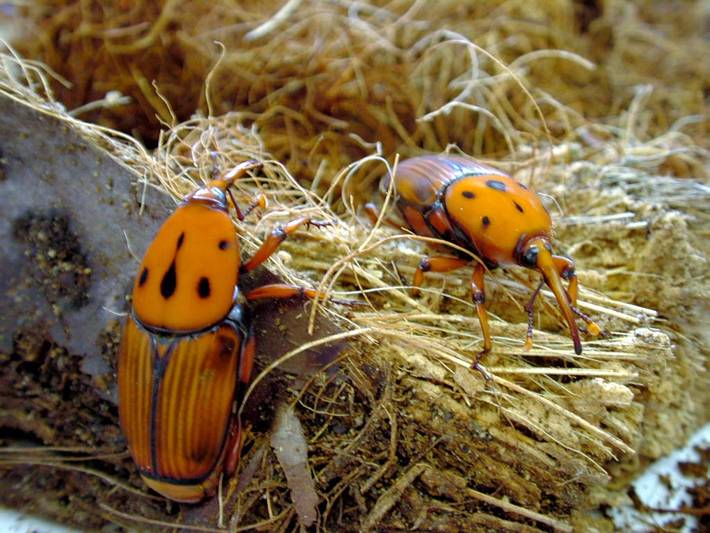 Red Palm Weevils feeding. Photo courtesy.
Red Palm Weevils feeding. Photo courtesy.
The Near East and North African countries can count on Food and Agriculture Organization of the United Nations (FAO) 's unwavering support in their fight to contain the spread of the Red Palm Weevil, one of the world's most invasive pest species.
Addressing the Red Palm Weevil Donor Meeting in Abu Dhabi, Graziano da Silva thanked the United Arab Emirates (UAE) including Sheikh Mansour bin Zayed Al Nahyan, UAE Deputy Prime Minister and Minister of Presidential Affairs, and Sheikh Nahayan Mabarak Al Nahayan, Minister for Tolerance, for hosting the event.
The meeting, co-organized by the UAE Ministry of Climate Change and Environment, the Khalifa International Award for Date Palm and Agricultural Innovation and FAO, brings together agriculture ministers from the Near East and North Africa region and key regional and international organizations.
The UN agency's Director-General, José Graziano da Silva praised the UAE's $2 million contribution to FAO's five-year regional programme to combat Red Palm Weevil. The funding was announced by Mariam Al Mehairi, UAE Minister of State for Food Security, during today's meeting.
The FAO Director-General also thanked Libya for pledging $250,000 and the Arab Organization for Agricultural Development for pledging $100,00. "FAO will continue promoting regional and international collaboration aimed at controlling and eradicating the pest," he added. Previous contributions include $2 million from Saudi Arabia and $100,000 from Oman.
"Containing, controlling and ultimately eradicating the Red Palm Weevil is possible and FAO is at the forefront of efforts in this regard," Graziano da Silva said.
RELATED CONTENT: FAO sounds the alarm on world’s most destructive banana disease
The Red Palm Weevil, an insect originating in South East Asia that has spread rapidly through the Near East and North Africa, is the most dangerous and destructive pest of palm trees worldwide. Feeding on the trees' growing tissue from the inside, it is particularly difficult to detect during the early stages of infestation.
Along with other palm species, the transboundary pest threatens the data palm, which, Graziano da Silva said, "has a long heritage for sustaining human lives and livelihoods in hot and arid areas" and is a "fundamental source of income and food security for rural communities as well as a significant contributor to the national economies of the region's countries.
This is particularly the case in the Arab Region, which accounts for some 77 percent of world date production as well as almost 70 percent of global date exports.
RELATED CONTENT: FAO helps Kenyan farmers rescue harvest from Fall Armyworm
FAO's role and required support
FAO's five-year regional Red Palm Weevil programme will benefit all countries in the Near East and North Africa region and is expected to reach millions of farmers. The total cost of the programme is $20 million
In his speech at today's donor meeting, Graziano da Silva outlined the programme, which focuses on three interrelated elements: research, capacity development and, transfer of knowledge and technology. The programme, the FAO Director-General noted, is underpinned by an integrated pest-management approach, one that has been particularly successful in Mauritania where the spread of Red Palm Weevil has been curbed, mostly thanks to the active participation of farmers and their cooperatives.
RELATED CONTENT: FAO launches mobile app to control fall armyworm
Two years ago, FAO hosted a Scientific Consultation and High-Level Meeting in Rome to unite the efforts to tackle the Red Palm Weevil. FAO has also joined forces with important partners, such as the Khalifa International Award for Date Palm and Agricultural Innovation; the Arab Organization for Agricultural Development; the International Centre for Agricultural Research in the Dry Areas, the International Center for Biosaline Agriculture, and the Mediterranean Agronomic Institute of Bari (CIHEAM).
FAO is developing simple yet powerful tools to assist farmers in better monitoring and managing the Red Palm Weevil. A mobile app, SusaHamra, is used to collect standard data when inspecting and treating palms and checking pheromone traps for Red Palm Weevil. A global platform is being established for mapping field data and analytics for better decision making. Remote sensing is being combined with artificial intelligence to map palm trees for improved monitoring of Red Palm Weevil spread.
















Comments powered by CComment